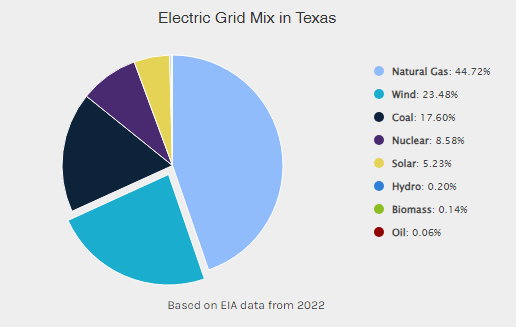June 21, 2023

Written By
Dhruv
When you think of Texas, you probably think of oil and gas—and rightfully so: Texas produces four times more oil than the next closest state.
However, did you know that Texas also produces the most wind power of any state in the nation?
In fact, if Texas were a country, it would be the 5th largest producer of wind energy in the world—trailing only the rest of the US (combined), China, Germany, and India.
The critical factors for successful wind power generation are the availability of land and an abundance of wind.
Texas has plenty of both.
This has led to the proliferation of wind turbines across the Lone Star State, generating abundant, cheap, clean energy.
In 2020, power generation from Texas wind farms surpassed that from coal generation for the first time, moving into second place behind natural gas.

The trouble is: Wind!
Wind power generation operates at the whim of mother nature.
Under normal conditions, wind generation is relatively steady, abundant, and cheap. However, the wind is never guaranteed to blow.
This creates a second challenge: imbalances between power generation and demand.
Wind power generation in Texas tends to be highest at night, while power consumption for things like air conditioning peaks at the hottest point of the day.
Baseload power generation refers to the minimum amount of generating capacity that the grid requires at all times.
It represents the continuous level of power required to meet consumers’ essential needs, regardless of how electricity demand fluctuates throughout the day.
Because the availability of wind power is unpredictable, additional sources of energy are needed when wind power generation dips or experiences an outage.
Even without any supply disruptions, demand can vary due to extreme weather, holidays, and myriad other factors.
This is one of the many situations where natural gas excels.
Natural gas power plants can ramp their output up or down at short notice to help balance the electricity grid whenever there are changes in wind power generation.
Moreover, natural gas plants can spin-up energy production much faster than nuclear or coal facilities, which is a major reason for using natural gas power generation as a “peaker” power source.
This ensures grid stability and prevents blackouts or disruptions in power supply.
As we’ve discussed in both this and our previous post, natural gas remains a valuable tool in our energy toolbox.
It offers distinct benefits over other fossil fuels and is a necessary complement to renewable power sources such as wind and solar.
Repeating a message that we shared last time: the energy transition needs natural gas; we’re on the same side.
Stay tuned for part 3 of the story...
Tags: Energy Transition

After many years of talk but no action, significant steps are finally being taken toward realizing a hydrogen-based energy ecosystem. One such effort involves leveraging existing natural gas...
© 2023-2026 Trellis Energy Software, Inc. | Terms of Use | Privacy Policy | Mailing Address